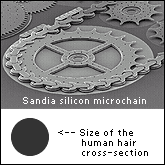Bicycle Chain for Fleas
 Sandia National Laboratories has engineered the world’s smallest chain. The distance between chain link centers is only 50 microns. In comparison, the diameter of a human hair is approximately 70 microns. This micro-chain has been made on the surface of a silicone substrate using photo-lithographic techniques, just like computer chips are made. It rests on, and is driven by, several micro-gears. Devices like this one that have physically moving parts on a computer chip are called MEMS – Micro Electro Mechanical Systems.
Sandia National Laboratories has engineered the world’s smallest chain. The distance between chain link centers is only 50 microns. In comparison, the diameter of a human hair is approximately 70 microns. This micro-chain has been made on the surface of a silicone substrate using photo-lithographic techniques, just like computer chips are made. It rests on, and is driven by, several micro-gears. Devices like this one that have physically moving parts on a computer chip are called MEMS – Micro Electro Mechanical Systems.
This micro-chain can be used to supply power to multiple parts of a micro system, very much like the drive belt in a 19th-century sewing factory. There, a central engine shaft powered by steam turned drive belts to power distant work stations - for example, sewing machines - before the dawn of the age of electricity. The microchain could also be used to drive microcamera shutters, and in mechanical timing and decoding.
Soon, all the electro-mechanical machines you know of and a host of new ones will be miniaturized and enabled with MEMS technology. Not too long from today, we may have micro-robots that one takes as a pill, which go directly to the problem/disease and fight it with targeted medicine delivery, or which zip around inside of our veins and arteries and clean clogs. On a less practical note, eventually, cats and dogs may have to deal with fleas on bicycles, or even solar driven micro motorcycles. The flea circus will have a whole new meaning.
About the Author
Anton Skorucak, MS
 Anton Skorucak is a founder and publisher of ScienceIQ.com. Anton Skorucak has a Master of Science (MS) degree in physics from the University of Southern California, Los Angeles, California and a B.Sc. in physics with a minor in material science from the McMaster University, Canada. He is the president and creator of PhysLink.com, a comprehensive physics and astronomy online education, research and reference web site.
Anton Skorucak is a founder and publisher of ScienceIQ.com. Anton Skorucak has a Master of Science (MS) degree in physics from the University of Southern California, Los Angeles, California and a B.Sc. in physics with a minor in material science from the McMaster University, Canada. He is the president and creator of PhysLink.com, a comprehensive physics and astronomy online education, research and reference web site.


